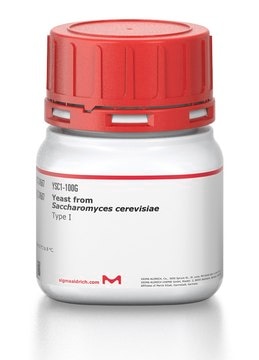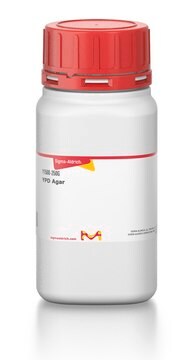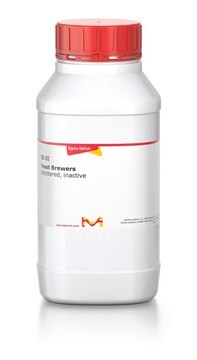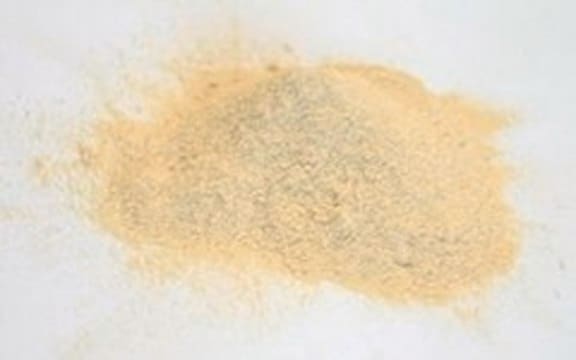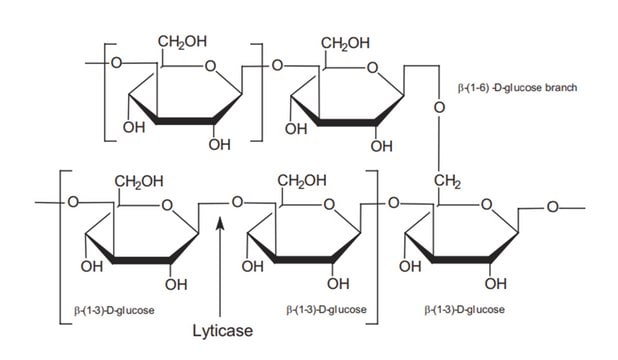YSC2
Yeast from Saccharomyces cerevisiae
Type II
Synonyme(s) :
(Bakers yeast)
Se connecterpour consulter vos tarifs contractuels et ceux de votre entreprise/organisme
About This Item
Code UNSPSC :
12352202
Nomenclature NACRES :
NA.24
Produits recommandés
Source biologique
Saccharomyces cerevisiae
Niveau de qualité
Type
Type II
Forme
powder or solid
Application(s)
food and beverages
microbiology
Température de stockage
2-8°C
Application
Yeast from Saccharomyces cerevisiae has been used:
- in yeast sample preparation for tube-gel electrophoresis (TGE) fractionation
- as a diet supplement to study its effect on the utilization of food waste as a diet for grass carp
- for fermentation of miscanthus and the cellulose-rich extract samples to produce ethanol
Actions biochimiques/physiologiques
Saccharomyces cerevisiae is a unicellular fungus. Yeast from S. cerevisiae is the widely used yeast species in bread and sourdoughs. It is used to produce several fermented beverages (cider, beer, 85s, and wine) and distilled beverages (brandy, sake, vodka, and whisky). S. cerevisiae has better tolerance for fermentation stresses than any other yeast species. Hence, it is a preferred starter culture for industrial fermentation.
Attention
Only approx. 10% will autolyze in aqueous buffer at 37 °C.
Notes préparatoires
Fast dried to yield 90% active, viable yeast in a convenient solid form.
Code de la classe de stockage
11 - Combustible Solids
Classe de danger pour l'eau (WGK)
WGK 3
Point d'éclair (°F)
Not applicable
Point d'éclair (°C)
Not applicable
Équipement de protection individuelle
Eyeshields, Gloves, type N95 (US)
Certificats d'analyse (COA)
Recherchez un Certificats d'analyse (COA) en saisissant le numéro de lot du produit. Les numéros de lot figurent sur l'étiquette du produit après les mots "Lot" ou "Batch".
Déjà en possession de ce produit ?
Retrouvez la documentation relative aux produits que vous avez récemment achetés dans la Bibliothèque de documents.
Les clients ont également consulté
Sivasamy Sethupathy et al.
Frontiers in microbiology, 11, 584812-584812 (2020-11-17)
Indole and its derivatives have been shown to interfere with the quorum sensing (QS) systems of a wide range of bacterial pathogens. While indole has been previously shown to inhibit QS in Serratia marcescens, the effects of various indole derivatives
Margaret Clarke et al.
PloS one, 5(1), e8585-e8585 (2010-01-07)
The vacuolar H+-ATPase, or V-ATPase, is a highly-conserved multi-subunit enzyme that transports protons across membranes at the expense of ATP. The resulting proton gradient serves many essential functions, among them energizing transport of small molecules such as neurotransmitters, and acidifying
Lacrimioara Senila et al.
Molecules (Basel, Switzerland), 25(11) (2020-06-07)
In this paper, the production of a second-generation bioethanol from lignocellulosic vineyard cutting wastes was investigated in order to define the optimal operating conditions of the autohydrolysis pretreatment, chlorite delignification and simultaneous saccharification and fermentation (SSF). The autohydrolysis of vine-shoot
Eric J Kalivoda et al.
PloS one, 8(7), e71267-e71267 (2013-08-08)
Biofilm-related infections are a major contributor to human disease, and the capacity for surface attachment and biofilm formation are key attributes for the pathogenesis of microbes. Serratia marcescens type I fimbriae-dependent biofilms are coordinated by the adenylate cyclase, CyaA, and
Pretreatment of miscanthus using 1, 3-dimethyl-imidazolium methyl phosphonate (DMIMMPh) ionic liquid for glucose recovery and ethanol production
Hassan El-Sayed RE, et al.
Royal Society of Chemistry Advances, 5(75), 61455-61464 (2015)
Notre équipe de scientifiques dispose d'une expérience dans tous les secteurs de la recherche, notamment en sciences de la vie, science des matériaux, synthèse chimique, chromatographie, analyse et dans de nombreux autres domaines..
Contacter notre Service technique